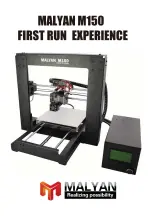
COPYRIGHT
C
1997 CANON INC. CANON LBP-2460 REV.0 APR. 1997 PRINTED IN JAPAN [IMPRIME AU JAPON]
Assembly Location Diagrams. These diagrams show
the locations of major assemblies of the machine. Their
names are identified in rectangular boxes. Below each box
is the number of the Figure which shows an exploded view
of the assembly.
Finding a Parts Number. Refer to the Assembly
Location Diagrams and find the Figure Number of the
assembly of interest. Turn to the page(s), locate the part on
the exploded view, and find its Key Number. Refer to the
Parts List on the page facing the exploded view and find
the Key Number, Part Number and quantity required for
your type of machine.
Note : While looking for a Part Number, pay particular
attention to the voltage listed in the SERIAL
NUMBER/REMARKS columm to ensure that the
Part Number selected is for your type of machine.
Immediate shipping or action regarding the part
depends on using its correct Part Number.
Parts List pages. The Parts List pages contain the
following columns and information.
(1) Figure and Key Number column. The first column
shows the Figure Number of the illustration corresponding
to the Parts List, and the Key Number that identifies the part
on the illustration.
(2) Part Number. The second column shows the Part
Number for the part. This Number must be used when
ordering replacement parts or assemblies described in the
description column do not have a Part Number and are not
stocked.
(3) Rank N. Parts marked"N"are service parts, but are
not stock items. They are produced on a special-order basis.
(4) Quantity column. The quantity shown in this
column is the number of parts used in the Figure. However,
the quantity listed for an assembly indicates the number of
that assembly per machine. The letters in this column
indicate that the quantity of a parts is not specified, allowing
the use of the number of parts needed for assembly and that
the quantity cannot be mentioned clearly.
(5) Description column. The Description column lists
the description that should be used when ordering the part.
(6) Serial Number/Remarks. When there are differ-
ences in the specifications of power suppply voltage,
frequency, etc., the differences are described in words or
indicated by one two or three letters in front of the serial
number.
(Example)
Serial number ABC00001
This is the descriptive
indicator.
If a model modified and a part is no longer interchangeable,
the serial number of machines for which the part can be
used is shown in this column. If there is no indication the
part can be used with all models.
Numerical Index. There is a Numerical Index at the
end of this catalog; it lists in numerical order every Part
Number contained in the Parts Lists. The Numerical Index
contains the following columns and information.
(1) Part Number. The first column shows the Part
Number.
(2) Figure and Key Number column. The second
column lists the Figure and Key Number for each
occurrence of the part in the illustrations.
Note : The last three digits (suffix) of the Parts Number
are called the Revision Number. The Revision
Number is changed if the part is modified.
Information regarding such changes will be pro-
vided by Service Information Bulletins. These
Bulletins should be read carefully.
HOW TO USE PARTS LISTS
viii
Summary of Contents for LBP-2460
Page 2: ......
Page 6: ......
Page 10: ...COPYRIGHT C 1997 CANON INC CANON LBP 2460 REV 0 APR 1997 PRINTED IN JAPAN IMPRIME AU JAPON iv ...
Page 12: ...COPYRIGHT C 1997 CANON INC CANON LBP 2460 REV 0 APR 1997 PRINTED IN JAPAN IMPRIME AU JAPON vi ...
Page 15: ......
Page 35: ......
Page 41: ......
Page 45: ......
Page 59: ......
Page 72: ......
Page 73: ......
Page 80: ......
Page 90: ......
Page 105: ......
Page 110: ......
Page 112: ......
Page 116: ......
Page 118: ......
Page 124: ......















































